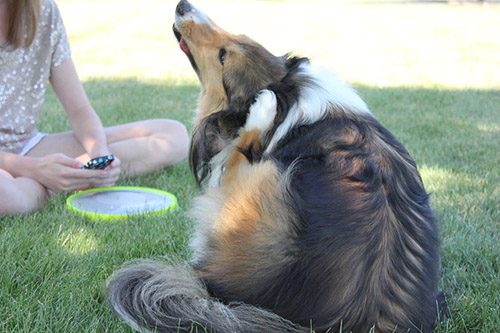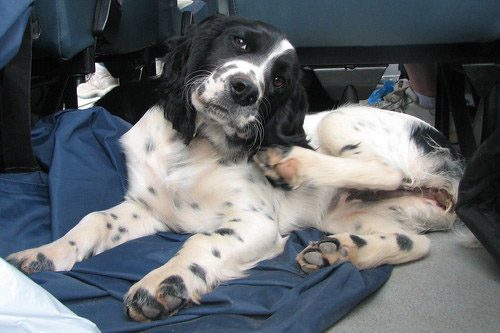Generally, itching that becomes troublesome in the dog is accompanied by other signs in addition to scratches such as nibbling or licking of the pruriginous area, rolling, shaking of the head, friction on the walls, floor or your legs. Pay attention to these signs!
Usually, conditions causing pruritus cause erythema, that is, redness of the skin or rash, but it is possible that the dog has no lesions at the beginning of the condition. . Make a habit of regularly inspecting your pet’s skin for signs of skin disease.

A dog that scratches or itches a lot, is this normal?
It is normal for your dog to scratch once in a while. When it scratches it never lasts long and takes place more or less randomly on one part of the body.
Often during intense itching dogs use everything they can to scratch themselves. Thus the dog scratches with the paw, bites, nibbles, licks insistently, rubs against the walls or even your legs. It can also frantically shake the ears in cases of otitis in dogs or pruritic lesions of the auricular flag.
On the other hand a dog that scratches on a particular area or on the whole body by insisting it is not normal. All in all if you have the impression to see a dog scratching all the time, there is a problem of skin disease of the dog.
Pruritus can be generalized to the whole body or localized to an area such as the ears or the ends of the legs.
If the responsible condition causes a strong inflammation or if it is chronic the skin can thicken or refine on the areas where it is scratching. You can also find alopecia (dog that loses its hair) where the dog scratches.
Associated with itching the dog may develop skin lesions such as redness, pimples, crusts, scales and excoriations (the skin is damaged and the superficial layers are eroded due to friction). These lesions can be anterior to scratching or secondarily to the appearance of pruritus.
What causes a dog to itch or scratch excessively?

Causes of pruritus in dogs are often related to inflammation of the skin (endogenous or externally).
How to help a dog itching or scratching?
Your veterinarian will look at the entire dog looking for parasites visible to the naked eye such as dog fleas or chiggers. He may be able to use a flea comb to do it.
If you have tried a good flea control and treated your house properly against fleas (see article on dog fleas) then a dermatology consultation is required.
Then by observing the location of the pruritus and the associated lesions it directs the complementary examinations for the diagnosis of the dog which is scratching. Complementary examinations are numerous. But in dermatology it often starts with microscopic observation of skin and hair cells. To take the sample, the veterinarian uses a transparent tape, a blade that presses on the lesions or scraped skin (he scrapes the skin with a blade of blunt knife to recover cells).
The first test will tell if there is a bacterial or fungal infection (by yeasts, which are fungi, for example), if there is an external parasite like dog scabies in the skin or not. Sometimes this first examination does not give conclusive results and the veterinarian makes a larger sample by biopsy to send it to a histological analysis laboratory.
If he suspects an allergic cause the veterinarian may look for the allergen causing this allergy by a test or blood test. For food allergies a special diet is used to make the diagnosis.
What treatment for the dog who is scratching?
==> Find Out How You can Heal Your Dog From Scratching and Itching Using HOME Remedies <==
If this is the first time your dog has been scratching in an intense and unexplained way, take it to your veterinarian who will often advise you to use a suitable external pest control. The choice of the anti-parasitic must include only the active ingredients that do not experience a significant resistance of the chips. Ask your veterinarian for advice.
The dog who scratches his skin with blood should be promptly taken to the vet for relief. We can put a collar on him and apply soothing shampoos or lotions while waiting to see him.
Corticosteroids are very often used by veterinarians to relieve the pruritus of the dog. However, finding the disease responsible for pruritus is often a priority because corticosteroids alone can not always treat the dog.
The dog who develops a bacterial superinfection will receive an anti-biotic. The treatment of pyoderma (bacterial infection of the skin) is long. It must be respected and make regular checks to be sure that the skin heals. Shampoos with regular antiseptics as well as moisturizing lotions of skin and dietary supplements can be added to the treatment for more efficiency.
Associated with corticosteroids or not other molecules have actions on the dog that scratches can be mentioned in the case of allergies for example antihistamines or immunomodulators. Discuss with your veterinarian.

 How to Safely remove ticks on your Dog?
How to Safely remove ticks on your Dog? Nematodes in Dogs: Symptoms & Treatment
Nematodes in Dogs: Symptoms & Treatment Dermatitis in Dogs: Symptoms & Treatment
Dermatitis in Dogs: Symptoms & Treatment Brain Injury in Dogs – Can a Dog recover from Brain Damage?
Brain Injury in Dogs – Can a Dog recover from Brain Damage? Heal Your Dog Naturally Review – Health Problems for Dogs Resolved!
Heal Your Dog Naturally Review – Health Problems for Dogs Resolved! Why Is My Dog Gaining Weight in winter?
Why Is My Dog Gaining Weight in winter?